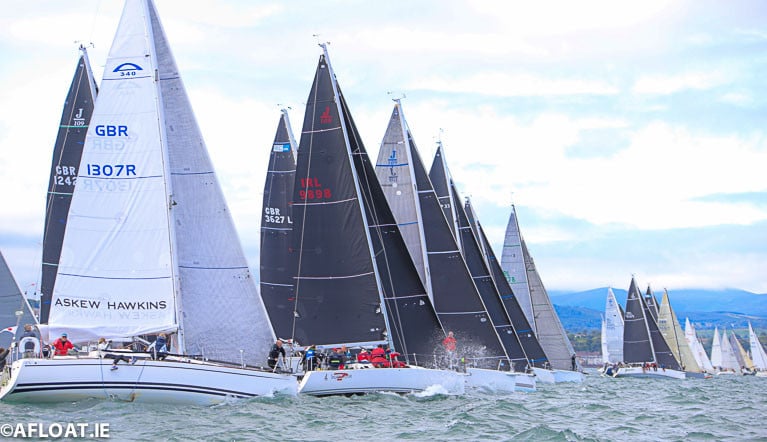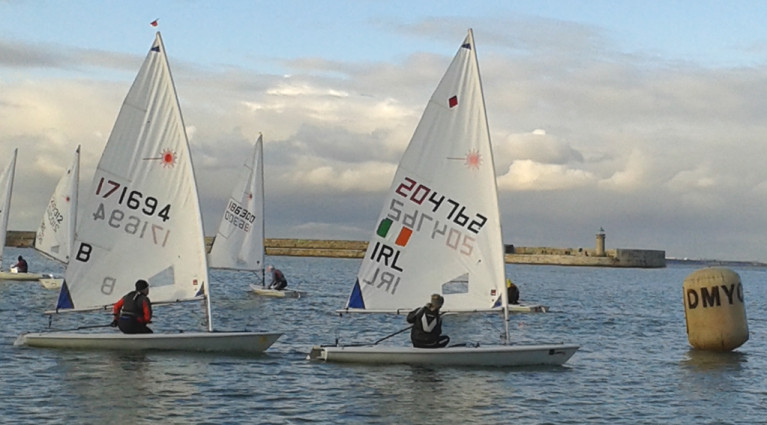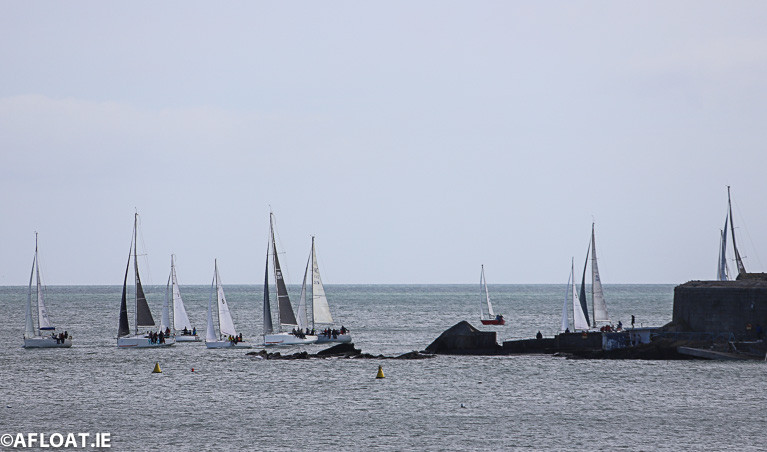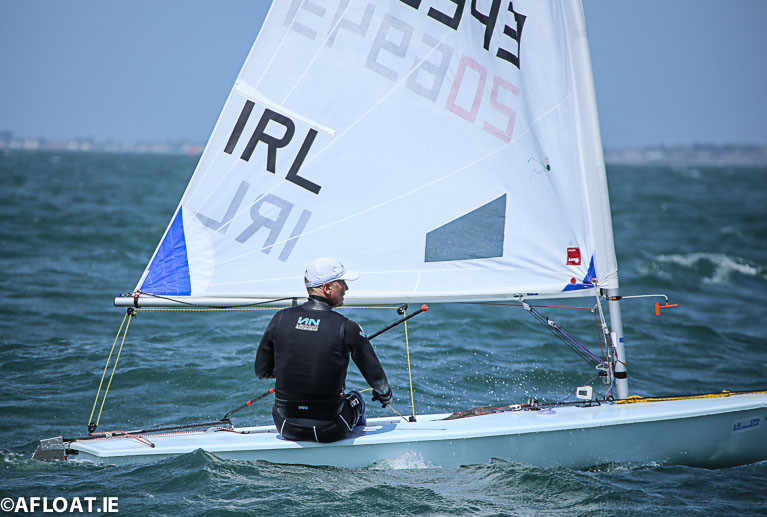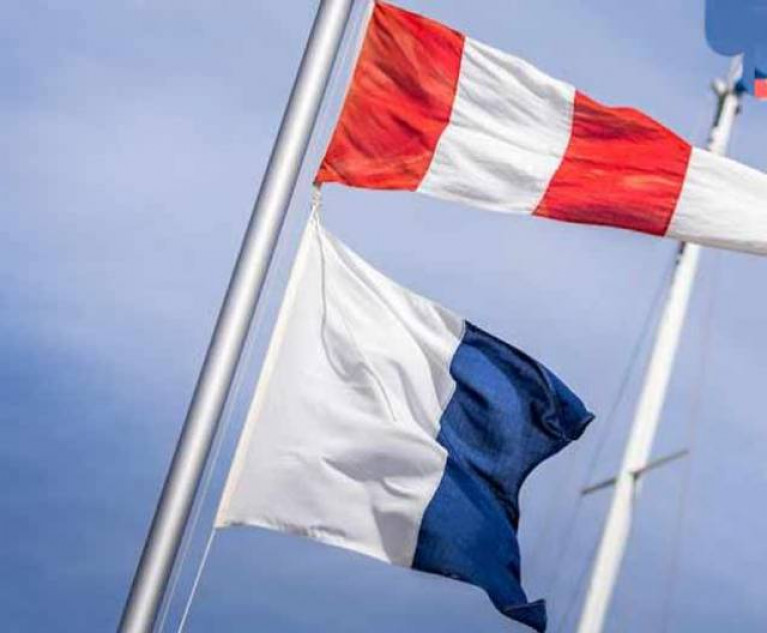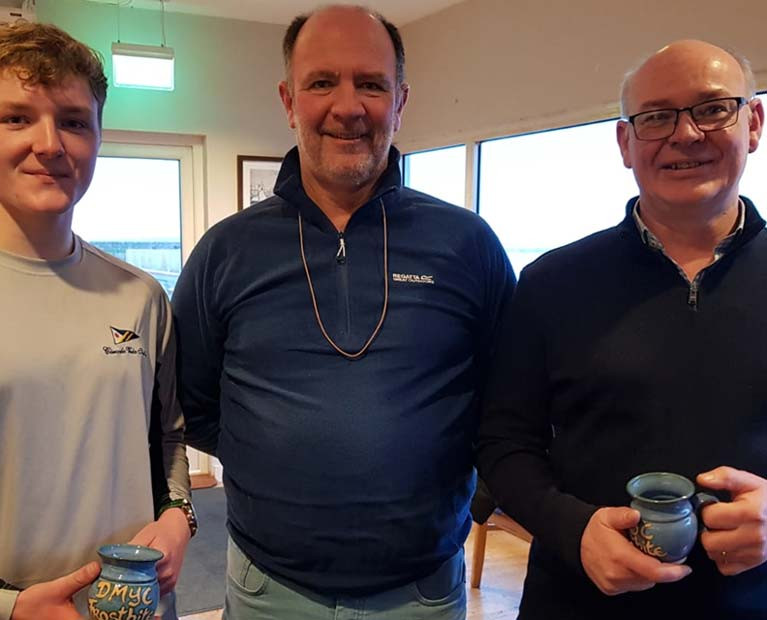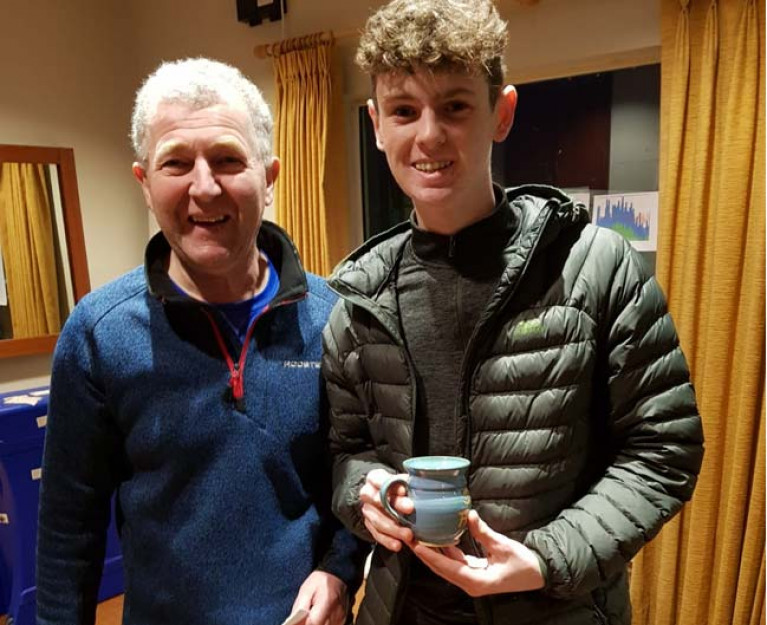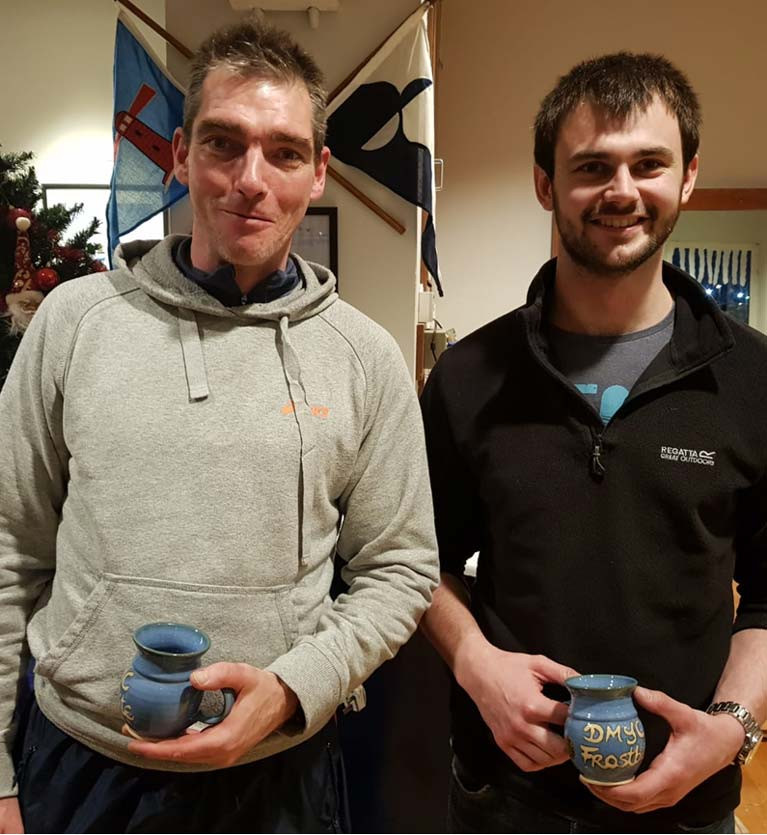Displaying items by tag: dmyc
The Dun Laoghaire Motor Yacht Club at the West Pier in Dun Laoghaire Harbour is busy preparing for its early June lift in of boats and cruisers.
The lift-in was postponed in April due to COVID-19 restrictions but the dinghy, keelboat and club season finally appears to be getting underway in line with social distancing guidelines next month.
Markings on the slipway are to remind members that social distancing rules apply when ashore and afloat.
A new Dublin Bay regatta involving the whole Dun Laoghaire sailing waterfront has been announced for July 31st to August 3rd.
The 'Dun Laoghaire Combined Clubs Solidarity Regatta 2020' is an initiative of all five of Dun Laoghaire's yacht clubs as a response to the COVID-19 interrupted season.
"The event is a joint effort of the DMYC, RIYC, RStGYC, NYC and DBSC", according to Mark McGibney, the sailing manager of the Royal Irish Yacht Club.
We plan to run this regatta from Friday 31st July to the 3rd August.
In these uncertain times, the clubs have also decided to 'book' the weekend of the 5th/6th September as reserve dates if the August dates fall through.
More details as we have them.
Read also: 2020 Irish Sailing Fixtures (The Beyond COVID-19 Version)
The DMYC has taken the decision to cancel the remaining Frostbite races in response to Government guidelines over the Coronavirus spread.
While it is acknowledged that the numbers taking part do not get to the threshold of outdoor events for cancellation, the view has been taken that cancellation is still the correct decision to take in the current climate.
All competitors in the 2019/20 Series will be emailed a discount voucher which can be used for next season’s DMYC Series.
The 2019/20 prizegiving will be hosted at a later date when the situation has normalised.
There was good news for DBSC Spring Chicken Series sailors who successfully completed their fourth race of the series in strong westerly winds this morning on Dublin Bay. The gusty conditions, however, proved too much for the DMYC Dinghy Frostbites this afternoon and unfortunately, that fixture was cancelled.
The 50-boat Citroen South sponsored Spring Chicken fleet sailed south to Dalkey Island passing a turning mark in the middle of Scotsman's Bay with some of the competitors – especially the sportsboats – hoisting spinnakers for the relatively tight downwind leg.
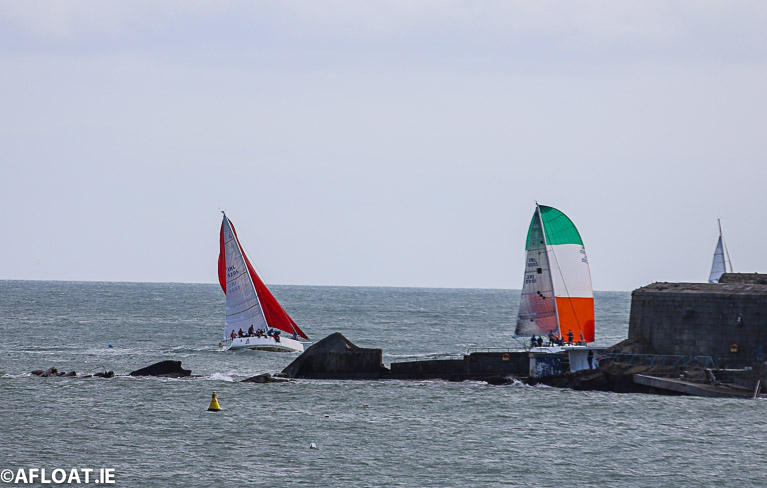 A tight downwind leg for J109s off the Forty Foot on Dublin Bay Photo: Afloat
A tight downwind leg for J109s off the Forty Foot on Dublin Bay Photo: Afloat
The final race of the DBSC series (the added extra race) will take place on March 22nd.
Weather Relents & Dun Laoghaire Dinghy Frostbite Racing Returns!
After three Sundays of no racing due to the ongoing storms of winter, the Dun Laoghaire DMYC Frostbite fleet was able to take to the water yesterday in what were still quite brisk winds but nothing like what we had seen over the past three weekends. During the week before, the forecast had been for quite light winds but late on Friday, XCWeather was showing a change and by late Saturday afternoon, the predictions were up to the high teens in terms of base wind strength. A positive sign for the afternoon was the bigger boats going out in the morning for their DBSC Spring Chicken Series and not being blown over.
The race start was brought forward by an hour to accommodate those armchair fans of a particular rugby match………of which there will be no further reference in this article/report. A brisk westerly greeted the competitors to the DMYC dinghy park and there were plenty of “cats’ paws” on the water. Air temperature was on the cool side, but it was bright.
With the wind out of the west, the longer dimensions of the harbour were available to set a two-lap triangular course with the weather mark set halfway along the inner pier off the West Pier and the gybe mark in the proximity of the HSS gantry. The leeward mark was set off the Boyd Memorial on the East Pier. From the committee boat perspective, the wind was reasonably steady in direction at 270° but my “samplers” of the course told me that the upper end of the beat was gusty and variable and the same could be said for the top reach. However, my Fireball “guinea-pig” was able to report that the angles of the reachs were good.
All the starts were clean and the only complication on the PY fleet was the Fireball of Frank Miller and Neil Cramer (14990) capsizing immediately after crossing the start line. Most of the fleet went left and worked the port hand side of the beat. First to show from a spinnaker perspective was Noel Butler and Stephen Oram (15061) with the Thompsons, Daniel & Harry (15156) not far behind them. Also, conspicuously, the Solo of Shane McCarthy wasn’t far off the lead bunch. This was a quick-fire race as there was plenty of breeze for the top reach and as the leaders sailed down the quieter second reach of the first lap, they had to take a slightly altered course to the leeward mark because of the third start of the day. In the end, less than thirty seconds covered the first three Fireballs at the finish. However, in handicap terms McCarthy turned a 2:30 deficit on the water to a 00:45 win on handicap. That left the first three Fireballs, Butler & Oram, Daniel & Harry Thompson and Alistair Court & Gordon Syme (14706) sandwiched between McCarthy and the Aero 7 of Alexander Rumball. On corrected time, 1:36 covered the top five boats.
The Laser Standard fleet has become a dedicated fleet of three – Messrs Arrowsmith, Murphy and O’Leary and in Race 1 this was the finishing order. The 4.7 numbers are also under pressure, but Rian Geraghty-McDonnell continued his winning ways in the first race of the day, followed by Luke Turvey and Evan Dargan Hayes. The Radials won the bragging rights for the biggest start of the day with 22 boats (to PY’s 21) and they enjoyed close racing with a finishing order of Adam Walsh, Conor Gorman, Sean Craig, Owen Laverty and first lady, Shirley Gilmore.
Given the short duration of the first race and the fact that the wind was still healthy but starting to drop, a longer four-lap Olympic course was set with time to rugby still not a problem. The weather mark needed slight tweaking, going slightly further south, or to port.
Again, three clean starts were completed and in the PY fleet, the blue and white spinnaker of the Thompsons was first to show. They had a scorching top reach to pull out a comfortable distance from Butler & Oram. Yet again the trend was to go left initially, before working the port side of the beat. The Thompsons held the lead for the first triangle but by the start of the sausage their lead had been cut dramatically by the chasing Butler & Oram. By the next windward mark, the order had changed and Butler & Oram won ultimately by 1:05 over the younger brothers. Frank Miller & Neil Cramer were third over the line, 1:29 down on the brothers. Yet again the handicap finishing order top five was populated by Fireballs and single-handers – Shane McCarthy’s Solo was 6:33 behind the first Fireball but closed to 16 seconds on handicap. And Alexander Rumball brought the Aero 7 home in fourth, 5:20 behind the Fireball but only 1:27 down on handicap.
In the Standard Lasers, Garvan Murphy took the honours with Chris Arrowsmith second and Conor O’Leary third. In the 4.7s, there was a family affair as Luke Turvey won from his brother Hugh, with Rian Geraghty-McDonnell third. And in the Laser Radials, Sean Craig took the win from Adam Walsh, Marco Sorgassi, Conor Gorman and Brendan Hughes.
An amendment to the sailing Instructions had advised competitors of the addition of a separate finishing mark, situated much closer to the committee boat. In the first race the outer limit mark for the start, a candy-striped mark was still in place at the finish and at least one boat used this as the outer limit for the finish. The errant act of sailing through the finish line when the blue flag is flying, indicating the committee boat is “On Station” for a finish, was prevalent again yesterday and in one of the Laser fleets the art of counting to four appeared to be a problem.
I think most people got ashore in time for THAT event on TV, but I would argue that the sailing was more enjoyable on the day!!
As this report is being written, there is a very wild Dublin Bay in evidence, and the last readout from the Dublin Bay buoy is: Wind Direction 267°, Gust Direction 315°, Avg. Wind 32 knots, Gust 46 knots. Just as well we were racing yesterday!
Frostbites: 23 February 2020.
PY Fleet; Race 1.
- Shane McCarthy, Solo
- Noel Butler & Stephen Oram, Fireball 15061
- Daniel & Harry Thompson, Fireball 15156
- Alistair Court & Gordon Syme, Fireball 14706
- Alexander Rumball, Aero 7.
Standard Lasers; Race 1
- Chris Arrowsmith
- Garvan Murphy
- Conor O’Leary.
Laser 4.7s
- Rian Geraghty-McDonnell
- Luke Turvey
- Evan Dargan-Hayes.
Laser Radials
- Adam Walsh
- Conor Gorman
- Sean Craig
- Owen Laverty
- Shirley Gilmore
PY Fleet; Race 2
- Noel Butler & Stephen Oram, Fireball 15061
- Shane McCarthy, Solo
- Alistair Court & Gordon Syme, Fireball 14706
- Frank Miller & Neil Cramer, Fireball 14990.
- Alexander Rumball, Aero 7
Standard Lasers
- Garvan Murphy
- Chris Arrowsmith
- Conor O’Leary.
Laser 4.7s
- Luke Turvey
- Hugh Turvey
- Rian Geraghty-McDonnell.
Laser Radials
- Sean Craig
- Adam Walsh
- Marco Sorgassi
- Conor Gorman
- Brendan Hughes.
Storm Dennis Cancels DMYC Frostbite Dinghy Races This Sunday
Yet another early call has been taken to cancel the DMYC Frostbites this Sunday at Dun Laoghaire Harbour with winds of mid to high twenties gusting to mid-forties predicted for race time. Storm Dennis has an element of “Denis the Menace” to him.
The proposal is to have an early start on Sunday 23rd , possibly 12:30, in order to accommodate those who want to watch rugby as well – a particular game from Twickenham.
DMYC Frostbite Dinghy Frostbites Fall Victim to February Gale
This afternoon's DMYC Frostbite Series racing for dinghies at Dun Laoghaire Harbour has been cancelled due to adverse weather with gusts in excess of 30 knots on Dublin Bay.
Gale force winds are predicted for the Irish Sea later today.
See live Dublin Bay webcam here
This morning's first race of the DBSC Spring Chicken Series did go ahead in the comparatively sheltered waters of Seapoint Bay.
Chilly Day on the Water at DMYC Dinghy Frostbites at Dun Laoghaire
A fleet in the mid-fifties braved a chilly Dun Laoghaire harbour today for the third race of Series 2 of the 2019/20 DMYC Frostbites. Wind strength during the morning in advance of racing wasn’t as brisk as forecast but the direction was right – westerly. The team racers were enjoying good conditions to confirm that the stronger winds forecast for the day hadn’t arrived.
However, the dominant weather feature was the chill factor and some preliminary soundings in the DMYC dinghy park suggested that the idea of a single long race to keep everyone active wasn’t a bad call. And so, the dye was cast! A five-lap Olympic course was signalled by Race Officer Cormac Bradley.
The committee boat set up just off the weather station on the East Pier and the 270° wind direction allowed a weather mark to be set just off the leading starboard leading light into the marina. The first reach took the fleet eastwards beyond the HSS gantry to a position off the Carlisle Pier, leaving the leeward mark between the weather station and the Boyd Memorial.
The PY fleet numbered 23 boats and included Wayfarers (2), GP 14s (2), Kona Windsurfers (3), RS Aeros (3), RS 200s (3), RS 400s (2), the Paralympic 2.4 (1), a Solo, and Fireballs (6). They had a General recall to start, one of the Aeros and one of the Fireballs leading an early charge over the line, causing the limit mark to disappear. That relegated them to the back of the queue! When they did get away, the trend seemed to be to go left into the middle of the harbour before picking a port-hand tack to get upwind towards the weather mark. The first rounding of the weather mark by the PY fleet looked busy and it wasn’t a red spinnaker that was first to break. Instead it was the blue of Alistair Court and Gordon Syme (14706) and another couple of reds were seen before Butler & Oram (15061) showed! Following what looked like two good reaches under spinnaker, the pecking order was Court, Frank Miller & Grattan Donnelly (14990), Louise McKenna & Hermine O’Keeffe (15016) and Ciaran Harken and Michael Keegan (14676) may have been ahead of the aforementioned Butler & Oram. Court/Syme lost their lead with a subsequent capsize on a beat and McKenna/O’Keeffe took on the mantle of leaders though they were hard-pressed by Miller/Donnelly. This latter combination also led the race for a period. However, it seemed that everyone in this race within a race was waiting for the “fat lady to sing”. Rounding the weather mark for the last time, two red spinnakers were well ahead of the fleet, followed by a third red spinnaker. It seems (in the post- race banter) that the first two reds were McKenna and Miller, who it was claimed had a double-digit lead of boat-lengths over Butler. For reasons that weren’t forthcoming, a severe luffing match ensued and there may have been turns taken, which opened a huge door of opportunity for Butler & Oram – which they availed of with both hands to take a win on the finish line. A “squeaky-bum” performance by the pair!!
However, the result on the water wasn’t good enough for them to occupy the podium places on handicap – those places went to the GP14 of Peter & Stephen Boyle (1st), followed by the Solo of Shane McCarthy and the Wayfarer of Dave Mulvin and Ronan O’Beirne. The three RS Aeros (7s) were led home by Kenny Rumball in 5th, followed by Brendan Foley in 6th and Mark Gavin in 7th respectively. Sarah Byrne led the two-person RS contingent home in 4th place while the Fireball of Butler & Oram had to be satisfied with 8th. There was some consternation at the handicap results with the GP 14 finishing 6:25 down on the Fireball but winning by 2:14 on handicap. The Solo was 55 seconds down on the GP14 but 42 seconds ahead of the Wayfarer. The “delta” between the Wayfarers on the water was 1:02, but on handicap, seven boats got in between them.
The three-boat Laser Standard fleet had three starters but only two finishers with Alan Hodgins taking the honours over David Field.
Four 4.7s raced with Kitty Flanagan taking the wing over siblings Luke and Hugh Turvey and Eimear Farrell closed the account in 4th place.
Twenty-six Radials assembled at the start line for racing with a transfer from the 4.7s in the form of Rian Geraghty-McDonnell. This young man has dominated the 4.7s thus far so clearly has decided to up his game for the balance of the series. He started off where he left off with another win on the water, but it was a very close race at the front with the lead boats overlapped every time they cam down past the committee boat on the sausage leg. There were no raised voices throughout any of the manoeuvres to get around the leeward mark and if there had been “fun and games” the senior fleet in this fleet, one Sean Craig would be quick to restore proper order. As it was, he finished in third behind the Geraghty-McDonnell and Kate Fahy. Behind him, in turn, were Judy O’Beirne and Alanna Coakley, leaving the males in the minority of the top five places.
Only one Laser seemed to be disappointed that there wasn’t a second race – everyone else seemed to be happy to go home.
DMYC Frostbites: Series 2; Round 3
PY Fleet:
1st Peter & Stephen Boyle (GP14), 2nd Shane McCarthy (Solo), 3rd David Mulvin & Ronan O’Beirne (Wayfarer).
Standard Lasers:
1st Alan Hodgins, 2nd David Field.
4.7s:
1st Kitty Flanagan, 2nd Luke Turvey, 3rd Hugh Turvey, 4th Eimear Farrell.
Laser Radials:
1st Rian Geraghty-McDonnell, 2nd Kate Fahy, 3rd Sean Craig, 4th Judy O’Beirne, 5th Alanna Coakley.
A quieter than usual DMYC clubhouse saw Peter & Stephen Boyle pick up a Frostbite Mug for their endeavours. There were other Mugs available for collection, but the rule is that you have to be there to get it!
DMYC Frostbites Sails Between Storms at Dun Laoghaire Harbour
With wind speeds of 37 knots being recorded off the end of the East Pier at lunchtime on Saturday (on a handheld anemometer) and Storm Brendan blowing hooligans today, the DMYC Dinghy Frostbites of Sunday 12th January could be said to have been sailed in the (relative) calm between the storms! And the wind behaved in accordance with the forecast, starting off quite strong first thing on Sunday morning (09:00) but dropping off in strength as the morning wore on. At about 11:30 it was down to 10/11 knots and during the race it dropped below ten but came back up again. The sun was out as well, but there was a slight coolness in the air.
Numbers were up again from last week with 27 boats in the PY fleet, 10+ in the Standard & 4.7 start and 28 in the Laser radial start. This Sunday we saw the return of the Kona Windsurfers, with Messrs Gibney and Walker, the regulars, joined by Julio David. The RS400s also added on to their fleet with the arrival of Sean and Conor Cleary and Dara McDonagh (and crew) giving Messrs Phelan & Leddy and Brian O’Hare and crew a four-boat race within the PY fleet. A second GP14, sailed by Peter & Stephen Boyle, joined the Flying Fifteen pairing of Ciara Mulvey and Peter Murphy and there were two boats challenges within the PY fleet for the RS Aeros (Brendan Foley & Mark Gavin) and the Wayfarers (Dave Mulvin & Ronan Beirne and Monica Schaeffer & Miriam McCarthy). The Sailing in Dublin (SID) Laser Vagos had three or four boats and the Fireballs had eleven starters in their fleet within a fleet.
 Fireballers Daniel (L) and Harry Thompson with their Frostbite Mugs for Race 2 in the PY Fleet. Photo: Frank Miller
Fireballers Daniel (L) and Harry Thompson with their Frostbite Mugs for Race 2 in the PY Fleet. Photo: Frank Miller
Given the weather conditions, the decision was taken to give the fleets a long race first to keep them active on the basis that if time and wind allowed a shorter second race could be provided. Speculation ashore, between the Frostbites “Director” and the Race Officer, was that a starboard-hand course might have to be set with the wind direction, but on getting out to the race area, a normal port-hand course was available. With a mean wind direction of 240º, the committee boat set up close to the end of the East Pier and put the weather mark just to the west of the entrance to the marina. The top reach extended across the windward shore of the harbour to a gybe mark that was to the east of the HSS gantry and the leeward mark sat behind and off to the port-hand side of the committee boat. The Wayfarer of Mulvin and Beirne was out early and sailed the two reaches under spinnaker and gave a healthy “thumbs-up” to Race Officer Cormac Bradley. Shane McCarthy in the Solo also tested the beat, by invitation, and declared that it was “good”. By prior arrangement a Fireball also sampled the course and advised that the start line was biased towards the committee boat – they were right, although the length of the start line was a bigger problem for the PY Fleet.
In contrast to last Sunday, all three starts got away at the first time of asking and while the initial approach to the first beat was to go left, the fleet soon spread themselves across the width of the course – always a good sight for the Race Officer. Five laps of an Olympic course were set and at the first weather mark there was a mix of Fireballs and RS400s in the lead bunch, with the Solo of McCarthy making his presence felt as well. The familiar red spinnaker of Noel Butler & Stephen Oram (FB 15061) was first to show, followed by the blue and white of the Thompson brothers, Daniel & Harry (FB 15156). Butler & Oram did their “normal trick” of sailing away from the fleet, but behind them there was lots of contests on the water. The leeward mark rounding also was a busy spot as the various fleets converged on it, from different angles, especially when the Lasers were added to the mix!
The first race lasted a healthy 43:38 and saw Butler & Oram take the win on the water. In Fireball terms, they were followed home by the Thompsons and Alistair Court & Gordon Syme (14706), though there were other boats in between. In the RS400 “race within a race”, debutants Sean and Conor Cleary took a “class” win from Dara McDonagh, Phelan & Leddy and Brian O’Hare.
The Kona finishing order was Robbie Walker, Des Gibney and Julio David, while Mulvin/Beirne took the Wayfarer win, the Boyles the GP 14 win, and Butler & Oram the handicap win, followed by McCarthy (Solo), the Boyle GP14, Sarah Byrne & crew in the RS200 and the Thompsons (FB). The winning margin on the water, Fireball to Solo was 9:25, which reduced to 00:38 after the application of handicaps. The Boyle’s performance won the Frostbite Mug for the PY Fleet.
The mixed Standard Lasers & Laser 4.7s is the smallest fleet, made up yesterday of three Standards and five or six 4.7s. The Standards finished in a tight sequence with Chris Arrowsmith winning from Alan Hodgins and David Field, Field’s performance good enough to get the Frostbite Mug. Rian Geraghty-McDonnell continued his domination of this Class with another win, followed home by Christian Ennis, a new name in the podium frame, Hugh Turvey and Archie Daly, another new name.
The Radial Fleet is a good mix of adults and Juniors with the adults represented by the likes of Sean Craig, Shirley Gilmore, Judy O’Beirne, Mary Chambers and Owen Laverty. However, in the lighter winds that we have had thus far the Juniors have been very prominent in the podium places and yesterday saw a mix of adults and Juniors in the top five finishers. The racing in this fleet can get very tight at the front and it is encouraging to see clusters of boats sailing “bow to transom” downwind with helms carefully watching those closest to them. Juniors don’t seem to be intimidated at all when Sean Craig, for example, sits on their transoms, hunting them down, waiting for a mistake! Yesterday, in Race 1, two Juniors took the honours with Hugh O’Connor winning and taking a Frostbite Mug, followed by Conor Gorman, Sean Craig, Judy O’Beirne and Shirley Gilmore.
Finishes on the water were offered to the stragglers to allow a second short race to be run. However, the first two marks had to be reset as the wind went southwards. This time the course was two triangles and having learned the lesson from the first time, the start line was lengthened. This time the contest on the line was even tighter, but again the three fleets got away at the first time of asking. The wind dropped below 10 knots but then came back up again and a race of half the duration of the first was completed.
In the PY fleet, class winners were Fireball – Butler & Oram, RS400 – Cleary & Cleary, GP14 – Boyle & Boyle, Wayfarer – Mulvin & Beirne, “by a nose” on the finish line, Kona – Walker, RS Aero – Brendan Foley. In handicap terms, a race time of 21:05 for Butler & Oram and a 00:59 second margin on the water was enough to take the PY win followed by a second Fireball, the Thompsons. On corrected time the handicap order was Butler & Oram (FB), Daniel & Harry Thompson (FB), Cleary & Cleary (RS400), Boyle & Boyle (GP14) and Patrick Hassett (2.4). Neil Colin & Margaret Casey (14775) were the third Fireball home.
In the Standard Lasers the order was Hodgins, Field and Arrowsmith, while in the 4.7s, there was an “upset” with Rian Geraghty-McDonnell not winning! That honour went to Christian Ennis, from Eimear Farrell and Archie Daly, a performance that gave him the Frostbite Mug.
Hugh O’Connor scored a double with a second race win in the Radials, followed by Sean Craig, Conor Gorman, Adam Leddy and Owen Laverty, the latter taking the Frostbite Mug.
DMYC Frostbites: Series 2; 12th January 2020
PY Fleet; Race 1.
Noel Butler & Stephen Oram (FB), Shane McCarthy (Solo), Peter & Stephen Boyle (GP14), Saran Byrne & crew (RS200), Daniel & Harry Thompson (FB).
PY Fleet; Race 2.
Noel Butler & Stephen Oram, Daniel & Harry Thompson, Sean & Conor Cleary (RS 400), Peter & Stephen Boyle, Patrick Hassett (2.4).
Standard Lasers; Race 1
Chris Arrowsmith, Alan Hodgins, David Field.
Standard Lasers; Race 2
Alan Hodgins, David Field, Chris Arrowsmith.
Laser 4.7s; Race 1
Rian Geraghty-McDonnell, Christian Ennis, Hugh Turvey, Archie Daly.
Laser 4.7s; Race 2
Christian Ennis, Eimear Farrell, Archie Daly.
Laser Radials; Race 1
Hugh O’Connor, Conor Gorman, Sean Craig, Judy O’Beirne, Shirley Gilmore.
Laser Radials; Race 2
Hugh O’Connor, Sean Craig, Conor Gorman, Adam Leddy, Owen Laverty.
DMYC Dinghy Frostbites Series 2 Underway in Balmy Conditions!
The second half of the Dun Laoghaire Motor Yacht Club’s Frostbite Series gut underway yesterday in what were almost balmy conditions for the 5th of January. From the middle of the week, this author’s favourite weather website XCWeather was suggesting that winds would be of the order of 12/13 knots with gusts of 26/27 knots from just west of south, but the flags within the harbour complex didn’t support that theory. Additionally, the readings from the Dublin Bay buoy for the two hours before my arrival at the club suggested that the base wind was correct but the gusts were only one or two knots more.
Temperature-wise it was mild, around the 10º mark and sunny, and though there were ominous black clouds building as the committee boat left the DMYC pontoon, it remained dry.
Fifty-one boats embraced the start of the Series with a 21-boat PY fleet, 5 Standard Lasers, 5 Laser 4.7s and 21 Laser Radials. Within the PY Fleet, the breakdown in boats was Fireball (8), RS 400 (2), RS 200 (2), RS Aero (2), Wayfarer (2), Solo (1) and Laser Vago (4). An early mention should be made of Dublin in Sailing’s support of the Frostbites – they put out multiple Laser Vagos every Sunday and thus enjoy their own internal competition as much as the fleet racing of the PY starters. Among the Fireballs was a new combination returning to the Class after a number of years away, at the start of a campaign that will culminate in participation in the Fireball Worlds to be hosted by Howth Yacht Club in August. Frank Cassidy and Ciaran Hickey are both long-standing members of the fleet that have been less active in recent years and we look forward to the next few months and the wit and repartee they will bring to the fleet – as well as their sailing prowess!
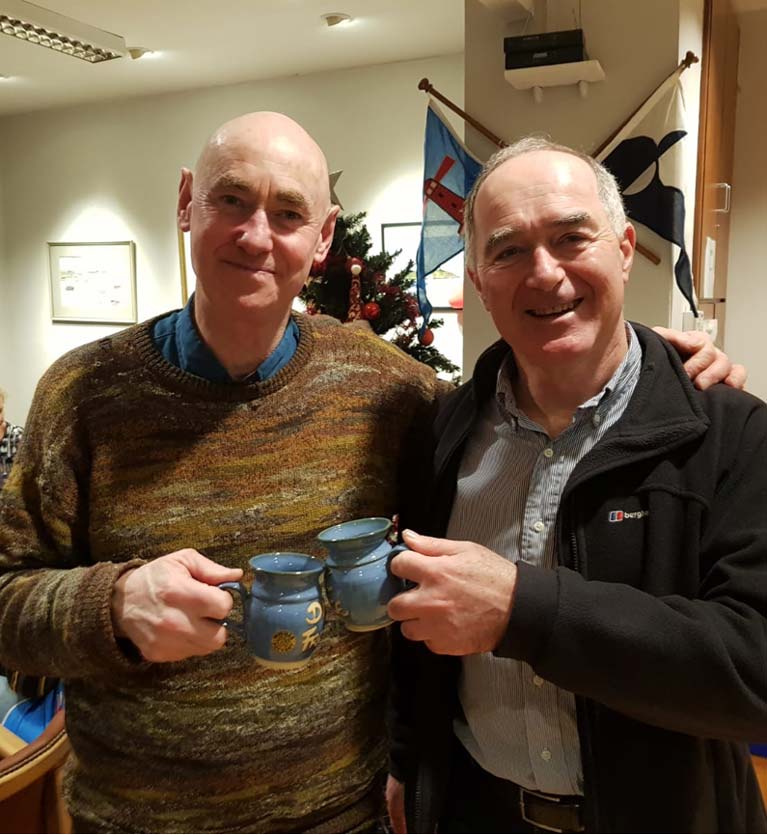 Frank Miller (L) and Ed Butler pick up the Frostbite Mugs for race 1 in the PY Fleet.
Frank Miller (L) and Ed Butler pick up the Frostbite Mugs for race 1 in the PY Fleet.
On getting out to the main body of the harbour, the wind was not quite what the Race Officer, Cormac Bradley, expected and rather than sitting off the end of the East Pier, the committee boat was just inside the end of the West Pier operating off a median wind direction of 210º. From the RO’s perspective, the wind direction looked reasonable stable, but competitors suggested otherwise afterwards. This left the weather mark about a third of the distance from the entrance to the marina to the HSS gantry, a gybe mark beyond the gantry and to leeward of it and a leeward mark just inside the entrance to the harbour and in the middle of the entrance. A three-lap Olympic was set for the first race of 2020 and the PY fleet got off to a clean start with the fleet distributed along the line with the majority going left initially. At the first showing of spinnakers, it was the red duster of Noel Butler & Stephen Oram, FB 15061 at the head of the fleet with possibly Frank Miller & Ed Butler FB14990 well up and the RS400 of Phelan & Leddy mixing it with the Fireballs. The Solo of Shane McCarthy was also well placed on the water, within the top ten at the first weather mark. As the race progressed, and is their wont, Butler & Oram pulled further and further away from the fleet.
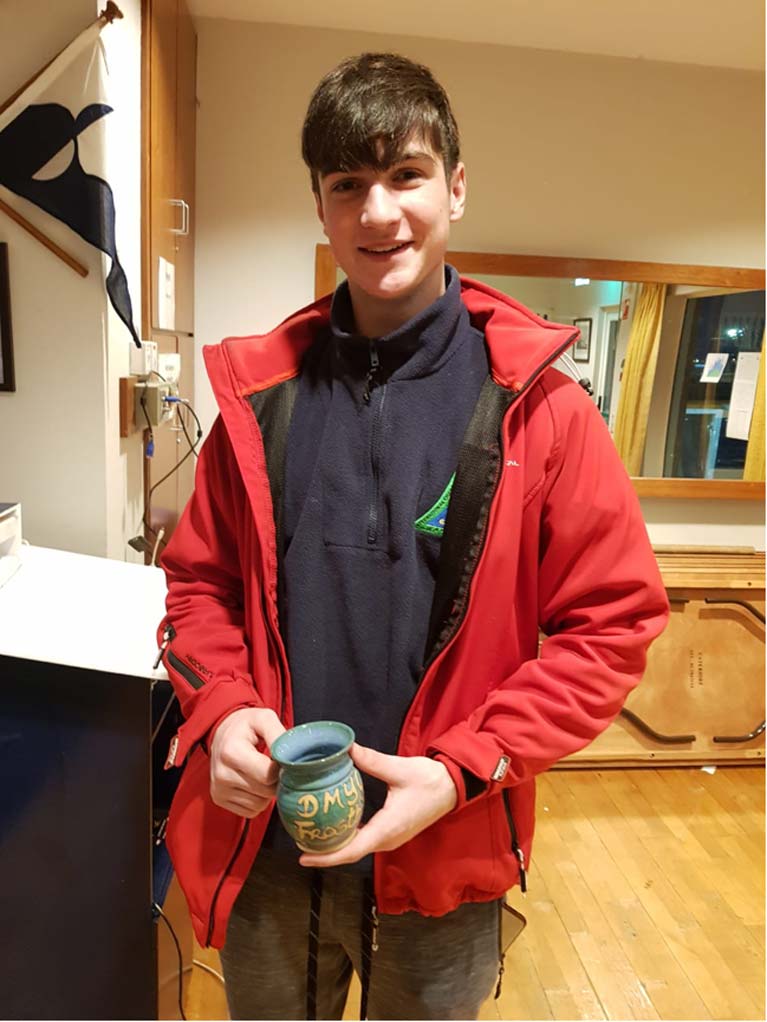 Adam Leddy collects his Frostbite Mug for the Laser Radials in Race 2 Photo: Frank MIller
Adam Leddy collects his Frostbite Mug for the Laser Radials in Race 2 Photo: Frank MIller
The two Laser starts were almost clear as well. The first start for the Standards and 4.7s was easy with only ten boats contesting what was a generous length of line. This fleet too went leftwards initially.
In the busier Radial start (of 21 boats), it was a much more contested line and one-high profile individual was OCS. He has championed the Laser participation in the Frostbites for the past two seasons and took his silent reaction to crossing the finish line in good spirit. This fleet also saw a 2nd half debut for Marco Sorgassi.
Due to the wind conditions, the first race had been fast, so the RO decided that in the prevailing conditions of 10 – 16 knots with one gust recorded at twenty, more of the same was the order of the day. However, the course needed to be pushed eastwards to accommodate a leftwards moving wind direction that couldn’t be accommodated by keeping things as is!
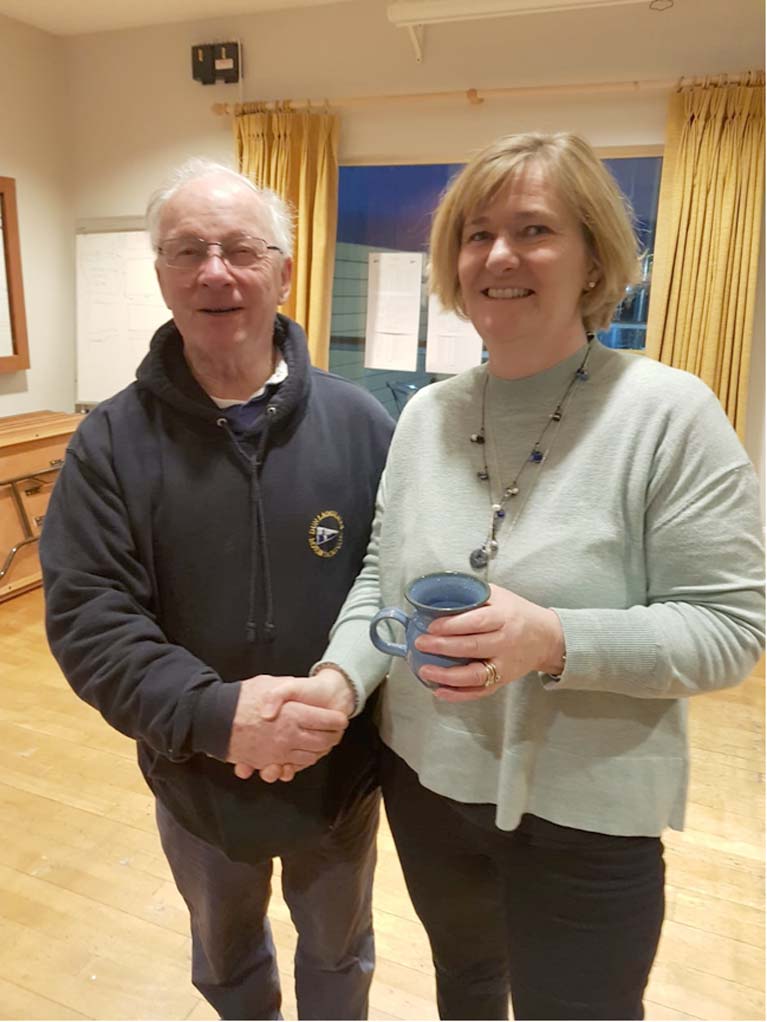 Judy O’Beirne takes the Frostbite Mug for the Laser Radials in Race 1 Photo: Frank MIller
Judy O’Beirne takes the Frostbite Mug for the Laser Radials in Race 1 Photo: Frank MIller
The five-lap ambition for the second race started to evaporate almost as soon as the countdown to the first start was initiated. The wind started to drop and what had been an almost immaculately behaved fleet for Race 1 became subject to multiple general recalls and ultimately the use of the black flag to get two of the fleets away. The only fleet to get away cleanly at the first time of asking was the Standard Lasers and the 4.7s, the other fleets required two bites at it, despite moving the limit mark twice! Throughout this process the wind continued to drop and at one stage we were down to as low as 4.4knots. While there was enough wind to get the fleet round the course, the leftward twitching wind made the legs something other than was intended and given that the committee boat was at the entrance to the harbour, a decision was made to relocate to the weather mark so that a less ambiguous shortened course signal could be flown.
For the PY Fleet, the lighter wind seemed to favour the Fireballs who took the first three places on handicap; Butler/Oram taking the win by 27 seconds from Josh Porter & Michael Ennis, 14695, both of whom had travelled down from N. Ireland to race. In third place by only 3 seconds were the “seasoned campaigners” Cassidy & Hickey 14713. Brian O’Hare and crew in the RS 400 were fourth, followed by Monica Schaeffer & Miriam McCarthy in their Wayfarer, squaring up the day series in the Class as David Mulvin & Ronan Beirne had won the first race between them. The RS Aeros of Brendan Foley and Mark Gavin were separated by 18 seconds in 7th and 8th respectively. The Solo fell afoul of the start procedure, with one other, so wasn’t in a position to challenge the top pecking order.
In the Standard Lasers, the finishing order was Alan Hodgins, Marc Coakley and Chris Arrowsmith, while in the 4.7s the ever consistent Rian Geraghty-McDonnell took first followed by Hugh Turvey and Archie Daly.
In the Laser Radials, Conor Gorman stepped up a gear to win, from his second in race 1, followed by Judy O’Beirne, Adam Leddy, Sean Craig and Adam Walsh.
A special commendation is given to the Thompsons, Harry, Daniel and father Colin who arrived as the club with the Fireball on the tow-hitch at 13:00, just as the committee boat left for the race course. With assistance from Oliver Proveur & Cariosa Power, both Frostbite stalwarts, they managed get fully rigged, changed and launched to make the first start on time.
The Race Management would like to thank all the competitors for the start practice they provided yesterday. The (generous) view, expressed in the DMYC afterwards was that the flooding tide and a very twitchy wind on the line may have been contributory factors in the need for multiple starts.
Frostbites: Series 2.
PY Fleet; Race 1
Noel Butler & Stephen Oram (Fireball 15061), Shane McCarthy (Solo), Paul Phelan & Alan Leddy (RS 400), Frank Miller & Ed Butler (Fireball 14990), Daniel & Harry Thompson (Fireball 15156).
PY Fleet; Race 2
Noel Butler & Stephen Oram, Michael Ennis & Josh Porter (Fireball 14695), Frank Cassidy & Ciaran Hickey (Fireball 14713), Brian O’Hare & Crew (RS400), Monica Schaeffer & Miriam McCarthy (Wayfarer).
Standard Lasers; Race 1
Chris Arrowsmith, Gavan Murphy, Conor O’Leary.
Standard Lasers; Race 2
Alan Hodgins, Marc Coakley, Chris Arrowsmith.
Laser 4.7s; Race 1
Rian Geraghty-McDonnell, Christian Ennis, Archie Daly.
Laser 4.7s; Race 2
Rian Geraghty-McDonnell, Hugh Turvey, Archie Daly.
Laser Radials; Race 1
Adam Walsh, Conor Gorman, Judy O’Beirne, David Dwyer, Marco Sorgassi.
Laser Radials; Race2
Conor Gorman, Judy O’Beirne, Adam Leddy, Sean Craig, Adam Walsh



























